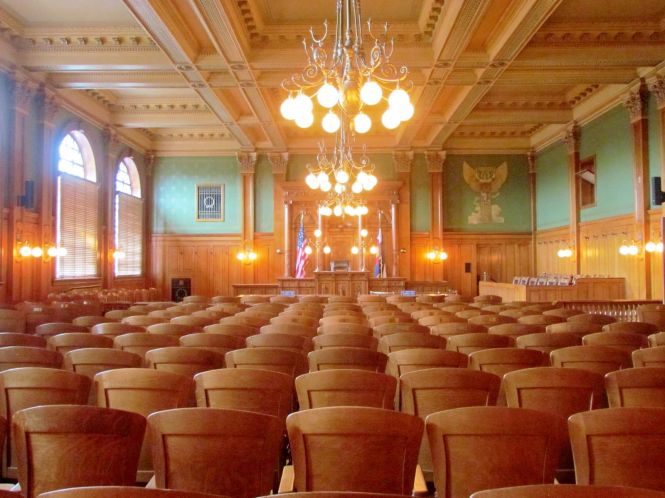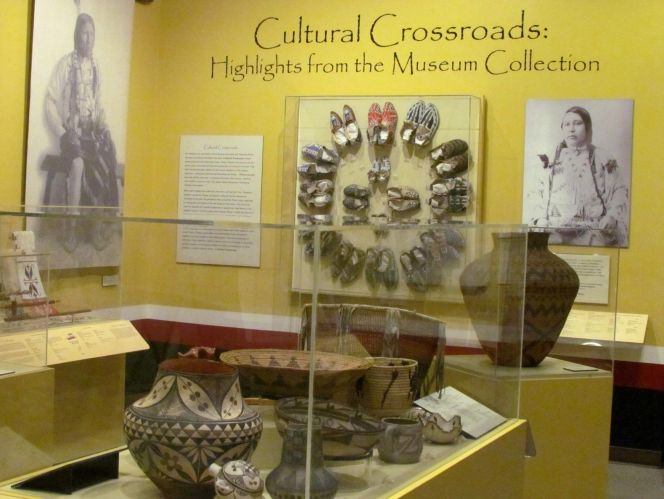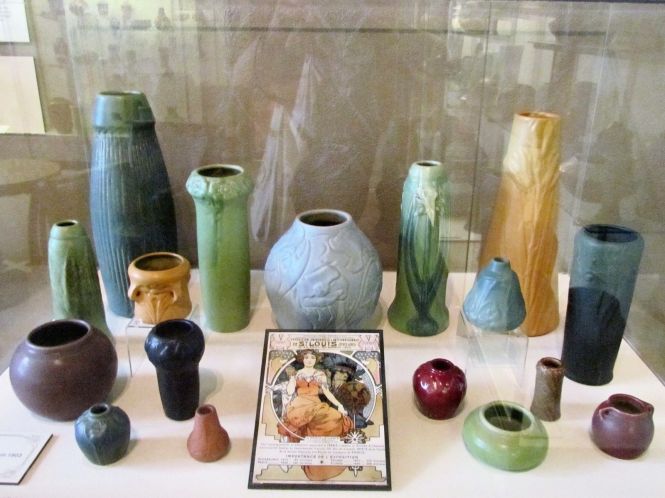Welcome back! As announced last week, today’s tour will afford further glimpses of the Colorado Springs Pioneers Museum, located in the historic El Paso County Courthouse. As it reopened on July 9, 2020 after being closed for over 3 months, you don’t have to limit yourself to a virtual visit (but please wear your mask and keep a safe distance from other visitors).
Once you walk up the front steps and through the front door into the lobby of the 2nd floor, you will behold one of the most arresting pieces of equipment inside the building—the 1917 Bird Cage elevator, fashioned by the same Otis Company still in the elevator business today. The interval between the courthouse’s opening in 1903 and the elevator’s installation was presumably due to a lack of funds.

Unless you suffer from claustrophobia and/or agoraphobia, let’s ride the now-automated contraption (it used to have an operator in the early days) to the third floor with its Division I Courtroom, restored to its original splendor. If you paid attention last week, you might have picked up on my description of “the seemingly central clock tower.” It was actually offset 8 feet to the west to allow this courtroom to be built large enough for its needs, but the asymmetry is discernible only from the outside.

Today I will focus on our museum’s “permanent” exhibits (whose lifetime is about 10 to 15 years). It is impossible to do them justice with a few photos and words, but I will try my best without overwhelming you with too much information (my apologies if you have already fallen asleep 😊). One of the reasons I enjoy volunteering here is the fact that our museum director, curator, and staff are committed to providing an honest view of the history of Colorado Springs and the region, while questioning long-held notions about “Manifest Destiny” and the settlement of the American West. The displays are inclusive and avoid the one-sided point-of-view that has proven so divisive and destructive for our society.
In The Story of Us, each letter of the alphabet commemorates a significant person, place, or event in Colorado Springs, from A for Antlers Hotel, one of the most famous and enduring guest accommodations (the other is the Broadmoor) , to Z for Zoo Park, the first zoo. S celebrates local Sankofa culture as shown in the diorama.


Cultural Crossroads honors the rich legacy of Indigenous peoples. The Front Range of the Rocky Mountains represented not only a geologic intersection between the Great Plains and Rocky Mountains, but a cultural one as well, where the Utes (known as The Mountain People) interacted with numerous Plains Tribes, among them Cheyenne, Arapaho, and Kiowa. Objects here represent more than 30 different tribes.


A Home of One’s Own pays tribute to author Helen Hunt Jackson, whose life and achievements I have described in a previous post. Visitors tend to be fascinated when they learn that the structure visible in the background represents a portion of Helen’s actual residence, not a replica. It was dis- and re-assembled not once, but twice, as it was also showcased in the museum’s previous home.

Any Place That is North and West (also the title of a Langston Hughes poem that makes me tearful each time I recite it) tells the inspiring stories of African-Americans who came to Colorado during the Great Migration, in which millions of Blacks left the Jim Crow South to find freedom and opportunity for themselves and their loved ones. Fannie Mae Duncan, founder and operator of Colorado Springs’ own Cotton Club, was the focus of an essay I wrote in honor of Black History Month earlier this year.


From Paris to the Plains retraces famed potter Arthur Van Briggle’s journey. A gifted artist from Ohio whose talent was fertilized by a sojourn in Paris (whose isn’t?), he came to Colorado Springs seeking a cure for his tuberculosis—in vain. He died at the age of 35, but not before having recreated a matte glaze dating back to the Ming dynasty which became all the rage. His accomplishments would have been impossible without the tireless support of his wife and fellow artist, Anne, who continued to create Van Briggle pottery after his death. His death mask and their intertwined hands on a vase of their making are among the most affecting artifacts.

Last but not least, the remarkable life of General William Jackson Palmer—Quaker, abolitionist, volunteer Union soldier in the Civil War, railroad builder, founder of Colorado Springs in 1871, and generous benefactor—is explored in Evidence, which opened in 2019 as the first of three new displays designed to celebrate our city’s approaching sesquicentennial. A new Cultural Crossroads exhibit scheduled to open this year was postponed until autumn 2021, and Colorado Springs@150 will open in January 2021.


If you live nearby and have never, or not for a long time, visited the Colorado Springs Pioneers Museum, or if you are traveling through the Pikes Peak region, please drop in. Something interesting and stimulating is certain to await you, so come and come often, especially since the museum is free (donations are gratefully accepted). For further information, follow the link to the museum’s website: https://www.cspm.org/




What a brilliant museum! It’s good to learn that its mission is inclusive, and that it seeks to tell the history of all the local communities, rather than focussing just on the WASPs and their myth of Manifest Destiny. I particularly like the approach to the Story of Us. Taking 26 themes, each based on a letter of the alphabet, is a good way of showing the breadth of the museum’s collection. But I’m intrigued – what’s the theme for the letter X? Children’s A to Z picture books face a similar problem – almost nothing in English starts with an X, and when it does it’s pronounced as if it were a Z ! Don’t you just love the English language? 🙂
LikeLiked by 2 people
Thank you, Mr. P. And how perspicacious of you to wonder about that remarkable letter X.
The creators of the exhibit came up with the following brilliant idea: X marks the spot, where the first stake of the Fountain Colony (Colorado Springs’ original name) was driven. The original commemorative marker that replaced the stake is now on display.
LikeLiked by 2 people
I wondered if that was what they’d do. I’ve also seen this approach used in a children’s ‘A to Z’ picture-book that aimed to teach the rudiments of the alphabet. In it, X marked the spot where a pirate had buried his treasure!
The managers at the CSPM are plainly on the ball – I was Googling to find out a bit more about what is plainly a top rate museum, and came across a fascinating piece on the “May Volunteer of the Month.” An inspired choice, in my humble opinion 😉
LikeLiked by 2 people
I guess the choices for this unusual letter are limited.
And thank you for your additional research and compliment. It’s much appreciated. 🙂
LikeLiked by 2 people
This post brings back my visit to Colorado Springs in 2017. (Was it really only three years ago? So much has happened since then!) Now you’ve included a second Jackson, William Jackson Palmer, to add to the first, Helen Hunt Jackson. In looking again at online information about her, I found that Emerson included five of her poems in his large anthology Parnassus; she wrote under the initials H.H., and that’s how she’s credited there. She came to Colorado Springs because of tuberculosis, and so did another of your latest additions, Arthur Van Briggle; he didn’t survive, she did.
In our 2017 conversation we discussed Helen Hunt Jackson’s novel Ramona, the 1928 movie made of it, and the song of the same name written for it. I see now that the woman who wrote that song’s music went by the name of Mabel Wayne but her real last name was the very German Wimpfheimer.
LikeLiked by 1 person
Thank you for remembering and recounting one of our previous interchanges, Steve. I need to clarify one little fact. Helen’s medical diagnosis was never officially TB, but asthma. I think it very likely that she had the former, as both her parents were affected. But she came to Colorado Springs because of our reputation as a destination for sufferers from respiratory diseases, like Artus.
I didn’t know about Frau Wimpfheimer, but what a wonderful name. Too bad she relinquished it, though I expect she was tired of people misspelling it. 🙂
Jackson, as a middle or surname, seemed to have been popular, and too many Jacksons might lead to confusion, as I sometimes notice during my tours.
There is also William Henry Jackson, famous photographer who lived to 99 and accompanied Ferdinand Hayden on several of his geologic surveys. He is credited with being the first to ever take photos of what later became Mesa Verde NP. You might enjoy his autobiography, “Time Exposure.” I vividly remember his description of the horrifying moment when he realized that all the glass plates he had used to take photos during one particular trip were empty. This would be akin to us returning from a trip of a lifetime only to find out that our memory card was defunct and would not divulge its data!
LikeLike
I’d never come across Langston Hughes. Is he well known in the US? It seems to me, from what Professor Google has just revealed, that he should be. Maybe you could tell us more about him and his poetry to celebrate next year’s Black History Month? (please forgive my presumption in suggesting what you should write, I’m sure you’ve got loads of stuff lined up and don’t need any more ideas from an ageing Brit! 🙂)
LikeLiked by 1 person
I agree that Langston Hughes should be well known, Mr. P, but I also have to admit that I only learned about him when I started to volunteer at the museum.
I think your suggestion is excellent and I will make an effort to get to know him and his writing better, then share it on my blog.
LikeLiked by 1 person
Great, I shall look forward to that.
LikeLike
We studied Langston Hughes when I was in high school in Iowa, in the 1960s. At least in that time and place, he was well known, and well-regarded. His work was included in some of my college classes, too.
LikeLiked by 1 person
Thank you for sharing your personal experiences, Linda. I definitely had not heard of him growing up in Germany, and since never attended school in the US, didn’t know if he was taught. It’s good to know that he is.
LikeLike
All right. This gets a Maine wowsah. What a museum! So many gems that I can’t even choose my favorite, although the poem by Langston Hughes really stands out. But so does everything else. You can bet that if I am ever visiting the Pikes Peak region, I will certainly visit that fabulous museum.
LikeLiked by 1 person
I’m glad the museum gets your approval, Laurie. I hope one of your trips will bring you and Clif out west one of these days (even if you are not crazy about traveling, if I remember correctly). 😊
LikeLiked by 1 person
No, I am not a traveler, but I sure would like to visit that museum.
LikeLiked by 1 person
Maybe the West’s beckoning will be too strong for you to resist one of these days, Laurie. 🙂
LikeLike
Fascinating place. I’m glad to learn that the Otis firm is still in business. Have you been giving tours since the reopening?
LikeLiked by 1 person
Thank you, Neil. The museum is open to visitors, but the only tours we are offering happen outdoors (with masks and safe distances). They focus on the history and architecture of the building, as well as the public art in the surrounding park. It’s a fun tour, but not many people have signed up for it.
LikeLiked by 1 person
What a fascinating museum. Your images of the interior were just as interesting as the artifacts and displays. Thanks for sharing, Tanja 🙂
LikeLiked by 1 person
I’m glad you find it fascinating, Vicki, thank you for your interest. The longer I volunteer there, the more I learn, and the more I appreciate what I learn.
LikeLiked by 1 person
I used to be a member of the National Trust of Victoria some 30 years ago and I loved spending the day out at old colonial properties and learning about their history and in turn, talking to visitors and answering their questions. As I have a fascinating history of my ancestors who first settled in Australia, I’ve researched a lot of the early 1800s in this country.
When I was studying Herbal Medicine, I researched and wrote a thesis of the history going back 1000 years. I’ve forgotten much of it, but still have the recipe of the herbs/spices grave robbers and funeral workers used dueing the Black Plague to protect them from the pandemic. Its quite fascinating and I wonder to this day if some of these ingredients would have any use in modern pandemics.
LikeLiked by 1 person
That research sounds very interesting, Vicki. It’s so much fun to see old places and try to imagine who lived there, and how.
And herbal medicine will never cease to be fascinating. Maybe you would enjoy re-reading your thesis (if you can still find it).
LikeLiked by 1 person
Yes, I still have the thesis, but have thrown out all my notes and re-homed about 80 health books. I have about 5 books books left on chronic ill health & Buddhist philosopy. There comes a stage in one’s life when its time to move on and develop new interests.
LikeLiked by 1 person
Very true.
LikeLiked by 1 person
I’ve got to visit it again…it’s been so long ago. If you make it to Victor check out the bird-cage elevator in the Victor Hotel. Still operating😊
LikeLiked by 1 person
Thank you, Dwight. I hope you will. And I have been meaning to get to the Victor museum for a while. I didn’t know about the bird cage elevator at the hotel, but will definitely check it out. The historic YWCA building in downtown Colo. Springs also has one still-functioning elevator.
LikeLike
I’m really curious about the woman in the brightly colored dress, next to the letter S. The drum and the seed-or-shell covered gourd look African, and the cloth looks like the printed Fanti cloth from West Africa. The ankle bracelet seems to be cowrie shell, too.Can you tell me more about her? I can’t quite read the informational plaque next to her.
LikeLiked by 1 person
I think the woman represents local Sankofa culture in Colorado Springs. I linked the word Sankofa to that movement in general, but you might also like to read the information on the museum’s website:
https://cspmstoryofus.com/
Once you get there, click on the letter S, and then click on Sankofa.
Thank you for your interest.
LikeLike
This looks like a great place to visit. Thank you for the tour!
LikeLiked by 1 person
Thank you for tagging along on the tour, Diane. 😊
LikeLike
Danke für die Vorstellung dieses wunderbaren Museums, Tanja!
Liebe Grüße
Brigitte
LikeLiked by 1 person
Danke für Dein Interesse, liebe Brigitte. Ich finde, es ist wirklich etwas Besonderes.
Alles Gute,
Tanja
LikeLike
I love the artifact with Arthur and Anne’s intertwined hands on a vase.
LikeLiked by 1 person
Thank you for noticing, Nirmala. I find this scene incredibly moving as well.
LikeLiked by 1 person